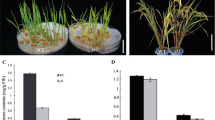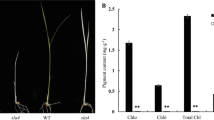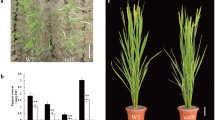Abstract
In cotyledons of etiolated seedlings light-dependent transformation of etioplasts to chloroplasts marks the transition from heterotrophic to autotrophic growth. Genetic factors required for this developmental step were identified by isolating mutants of Arabidopsis thaliana that were impaired in chloroplast development in cotyledons but not in true leaves. Several mutants with chlorophyll-deficient cotyledons were isolated and dubbed snowy cotyledon (sco). Here we describe the identification and detailed characterization of the snowy cotyledon 2 mutant. The mutated SCO2 gene was identified using a map-based cloning strategy. SCO2 was shown to encode a novel protein which contains a single DnaJ-like zinc finger domain. The SCO2 protein fused to GFP was shown to be present in chloroplasts. Inactivation of SCO2 has almost no detectable impact on the levels of transcripts encoding plastid-specific proteins but leads to a significant reduction of plastid protein levels. Even though transcripts of SCO2 have been found ubiquitously in green tissues as well as in roots phenotypic changes due to SCO2 inactivation are confined to cotyledons. The cotyledons in embryos of sco2 are unaffected in their chloroplast biogenesis. Upon precocious germination seedlings of sco2 and wild type are indistinguishable. The SCO2 mutation affects chloroplast biogenesis only at the end of dormancy during seed germination. The transition from heterotrophic to autotrophic growth is dramatically impaired in sco2 when seedlings were kept in the dark for more than 5 days prior to light exposure.








Similar content being viewed by others
References
Albrecht V, Ingenfeld A, Apel K (2006) Characterization of the snowy cotyledon 1 mutant of Arabidopsis thaliana: the impact of chloroplast elongation factor G on chloroplast development and plant vitality. Plant Mol Biol 60:507–518
Asano T, Yoshioka Y, Machida Y (2004) A defect in atToc159 of Arabidopsis thaliana causes severe defects in leaf development. Genes Genet Syst 79:207–212
Borisjuk L, Nguyen TH, Neuberger T, Rutten T, Tschiersch H, Claus B, Feussner I, Webb AG, Jakob P, Weber H, Wobus U, Rolletschek H (2005) Gradients of lipid storage, photosynthesis and plastid differentiation in developing soybean seeds. New Phytol 167:761–776
Borisjuk L, Rolletschek H, Walenta S, Panitz R, Wobus U, Weber H (2003) Energy status and its control on embryogenesis of legumes: ATP distribution within Vicia faba embryos is developmentally regulated and correlated with photosynthetic capacity. Plant J 36:318–329
Cheetham ME, Caplan AJ (1998) Structure, function and evolution of DnaJ: conservation and adaptation of chaperone function. Cell Stress Chaperones 3:28–36
Chou ML, Fitzpatrick LM, Tu SL, Budziszewski G, Potter-Lewis S, Akita M, Levin JZ, Keegstra K, Li HM (2003) Tic40, a membrane-anchored co-chaperone homolog in the chloroplast protein translocon. Embo J 22:2970–2980
Clough SJ, Bent AF (1998) Floral dip: a simplified method for Agrobacterium-mediated transformation of Arabidopsis thaliana. Plant J 16:735–743
Gutensohn M, Pahnke S, Kolukisaoglu U, Schulz B, Schierhorn A, Voigt A, Hust B, Rollwitz I, Stockel J, Geimer S, Albrecht V, Flugge UI, Klosgen RB (2004) Characterization of a T-DNA insertion mutant for the protein import receptor atToc33 from chloroplasts. Mol Genet Genomics 272:379–396
Gutierrez-Nava Mde L, Gillmor CS, Jimenez LF, Guevara-Garcia A, Leon P (2004) CHLOROPLAST BIOGENESIS genes act cell and noncell autonomously in early chloroplast development. Plant Physiol 135:471–482
Ishizaki Y, Tsunoyama Y, Hatano K, Ando K, Kato K, Shinmyo A, Kobori M, Takeba G, Nakahira Y, Shiina T (2005) A nuclear-encoded sigma factor, Arabidopsis SIG6, recognizes sigma-70 type chloroplast promoters and regulates early chloroplast development in cotyledons. Plant J 42:133–144
Kim C, Apel K (2004) Substrate-dependent and organ-specific chloroplast protein import in planta. Plant Cell 16:88–98
Lyles MM, Gilbert HF (1991) Catalysis of the oxidative folding of ribonuclease A by protein disulfide isomerase: dependence of the rate on the composition of the redox buffer. Biochemistry 30:613–619
Miernyk JA (1999) Protein folding in the plant cell. Plant Physiol 121:695–703
op den Camp RG, Przybyla D, Ochsenbein C, Laloi C, Kim C, Danon A, Wagner D, Hideg E, Gobel C, Feussner I, Nater M, Apel K (2003) Rapid induction of distinct stress responses after the release of singlet oxygen in Arabidopsis. Plant Cell 15:2320–2332
Porra RJ (2002) The chequered history of the development and use of simultaneous equations for the accurate determination of chlorophylls a and b. Photosynth Res 73:149–156
Privat I, Hakimi MA, Buhot L, Favory JJ, Mache-Lerbs S (2003) Characterization of Arabidopsis plastid sigma-like transcription factors SIG1, SIG2 and SIG3. Plant Mol Biol 51:385–399
Runge S, van Cleve B, Lebedev N, Armstrong G, Apel K (1995) Isolation and classification of chlorophyll-deficient xantha mutants of Arabidopsis thaliana. Planta 197:490–500
Shimada H, Mochizuki M, Ogura K, Froehlich JE, Osteryoung KW, Shirano Y, Shibata D, Masuda S, Mori K, Takamiya KI (2007) Arabidopsis cotyledon-specific chloroplast biogenesis factor CYO1 is a protein disulfide isomerase. Plant Cell 19(10):3157–3169
Shirano Y, Shimada H, Kanamaru K, Fujiwara M, Tanaka K, Takahashi H, Unno K, Sato S, Tabata S, Hayashi H, Miyake C, Yokota A, Shibata D (2000) Chloroplast development in Arabidopsis thaliana requires the nuclear-encoded transcription factor sigma B. FEBS Lett 485:178–182
Sundberg E, Slagter JG, Fridborg I, Cleary SP, Robinson C, Coupland G (1997) ALBINO3, an Arabidopsis nuclear gene essential for chloroplast differentiation, encodes a chloroplast protein that shows homology to proteins present in bacterial membranes and yeast mitochondria. Plant Cell 9:717–730
Yamamoto YY, Puente P, Deng XW (2000) An Arabidopsis cotyledon-specific albino locus: a possible role in 16S rRNA maturation. Plant Cell Physiol 41:68–76
Acknowledgments
We are grateful to Mena Nater for her helpful advices and to André Imboden for taking care for the plants.
Author information
Authors and Affiliations
Corresponding author
Rights and permissions
About this article
Cite this article
Albrecht, V., Ingenfeld, A. & Apel, K. Snowy cotyledon 2: the identification of a zinc finger domain protein essential for chloroplast development in cotyledons but not in true leaves. Plant Mol Biol 66, 599–608 (2008). https://doi.org/10.1007/s11103-008-9291-y
Received:
Accepted:
Published:
Issue Date:
DOI: https://doi.org/10.1007/s11103-008-9291-y




